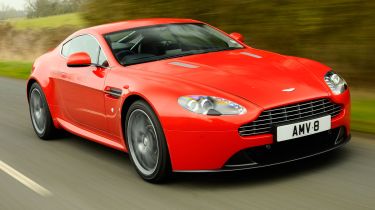Aston Martin V8 Vantage
Updated V8 Vantage is better than ever – and all for a lower price

It’s been around for seven years, but the V8 Vantage is better than ever thanks to some extensive changes and a lower price. The design inside and out is ageing gracefully and the 4.7-litre V8 is still impressive. It’s outshone by the new 911 for technology, but sharper steering and softer suspension make the Aston more fun and easier to live with than before.
The Aston Martin V8 Vantage Coupe has come down in price by £5,900, but that doesn’t mean you get less for your money.
Quite the opposite. To coincide with the price cut the Vantage has received its most thorough round of updates since 2008 – a strategy that’s more akin to Alfa than Aston.
To look at it, you wouldn’t know this Vantage has been around for seven years: it still blends elegance and aggression, and makes the new Porsche 911 look plain.
A lower front splitter than before and a new rear diffuser are taken from the 430bhp Vantage S and finished in matt black as standard (they can be ordered in carbon fibre, too). The side sills are also more sculpted, although not as pronounced as on the Vantage S.
Besides red stitching on the seats – to match the new Red Lion paint colour – the cabin has been left alone. So it’s testament to the original design that it still feels so special when you get in.
Used - available now

2023 Aston Martin
Vantage
19,000 milesAutomaticPetrol4.0L
Cash £69,300
2023 Aston Martin
Vantage
16,108 milesAutomaticPetrol4.0L
Cash £76,995The leather-wrapped dash, suede headliner and chunky metal switchgear are all top-quality, but in terms of functionality the pop-up sat-nav screen and fiddly audio controls are a generation behind the new 911’s.
Aston hasn’t tinkered with the potent 420bhp 4.7-litre V8, so acceleration is as brisk as ever, but the steering ratio, brakes, suspension settings and tyres have all been tweaked. There’s also the option of a seven-speed Sportshift automated manual box (£4,999), instead of the old six-speeder, although our base-spec test car was fitted with the snappy six-speed manual.
The first thing you notice is the quicker steering ratio, down to 15:1 from 17:1, which takes a few corners to get used to. While the nose darts in with a flick of the wrists and the whole car feels more alert, there’s none of the high-speed nervousness that can sometimes affect short-ratio steering racks.
The way the wheel loads up in fast turns helps you to place the car accurately on the road, but it could do with a lighter feel at low speeds. All four tyres are 10mm wider, so you can carry more speed in corners before they lose their purchase on the road.
But there’s a downside. While the engine sounds as glorious as ever to passers by, the larger rubber means more tyre roar in the cabin. Add this to the transmission whine, and while you can hear the V8 bellow above 4,000rpm, it never sounds as epic from the driver’s seat as you’d expect.
Instead of firming up the suspension to match the quicker steering and bigger brakes, Aston has softened the springs and dampers. The difference is subtle, but the way it deals with really bad surfaces is more polished and there’s no great increase in body roll – proof that you don’t need rock-hard suspension for a sporty drive.
The same changes have also been applied to the Roadster, and its price is cut by £5,000 to £92,995. If you’re prepared to sacrifice comfort for handling the Vantage S is still the pinnacle of the range, and it’s also cheaper, by £2,205, at £99,995.







